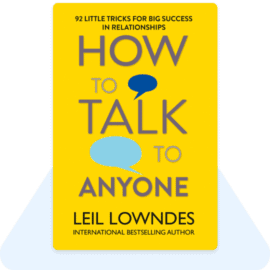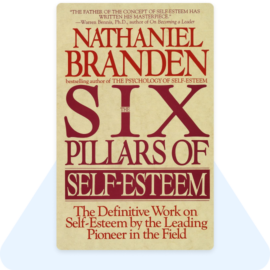What is that magic quality that makes some people instantly loved and respected? Everyone wants to be their friend. In business, they rise swiftly to the top of the corporate ladder. What is their “Midas touch?” It boils down to a more skillful way of dealing with people. Today we are going to talk about the same book. How to talk to Anyone, little tricks for big success in Relationships, written by Leil Lowndes, where we will talk about 51 techniques, which will help you in every stage of your life, beat personal, job, or business.
The author has spent her career teaching people how to communicate for success. She offers lots of easy and effective sure-shot success techniques in this book. In this information-packed book, you’ll find dynamite first impressions, master small talk & big talk, body language, talk like a VIP or celebrity, make your phone a powerful communications tool, and many more.
Let’s understand all 51 techniques in detail.
1. The flooding smile
Don’t flash an immediate smile when you greet someone, as though anyone who walked into your line of sight would be the beneficiary. Instead, look at the other person’s face for a second. Pause. Soak in their persona. Then let a big, warm, responsive smile flood your face and overflow into your eyes. It will engulf the recipient like a friendly wave.
2. Sticky eyes
Pretend your eyes are glued to your conversation partners with sticky warm taffy. Don’t break eye contact even after they have finished speaking. When you must look away, do it slowly, reluctantly, stretching the gooey taffy until the tiny string finally breaks.
3. Epoxy eyes
This brazen technique packs a powerful punch. First, watch your target person even when someone else is talking. Then, no matter who speaks, look at the man or woman you want to impact.
4. Hans’s horse sense
Make it a habit to get on a dual track while talking. Express yourself, but keep a keen eye on how your listener reacts to what you’re saying. Then plan your moves accordingly. If a horse can do it, so can a human. People will tell you to pick up on everything. You never miss a trick. You’ve got horse sense.
5. Watch the scene before you make the scene
Rehearse being the super somebody you want to be ahead of time. See yourself walking around with hang by your teeth posture, shaking hands, smiling the flooding smile, and making sticky eyes. Hear yourself chatting comfortably with everyone. Visualize yourself as a super somebody. Then it all happens automatically.
6. Prosaic with passion
Are you worried about your first words? Fear not, because 80 percent of your listener’s impression is not about your comments. Almost anything you say at first is fine. No matter how prosaic the text, an empathetic mood, an upbeat demeanor, and passionate delivery make you sound excited.
7. Never the naked city
Whenever someone asks you the inevitable, “where are you from?” Never, ever, unfairly challenge their powers of imagination with a one-word answer. Instead, learn exciting facts about your hometown that conversational partners can comment on. Then, when they say something clever in response to your bait, they think you’re a great conversationalist.
8. Never the naked job
When asked the inevitable “and what do you do,” you may think, “I’m an economist/an educator/an engineer” This gives enough information to engender good conversation. However, to one who is not an economist, educator, or engineer, you might as well be saying, “I’m a paleontologist/psychoanalyst/” flesh it out. Throw some delicious facts about your job for new acquaintances to munch on. Otherwise, they’ll soon excuse themselves, preferring the snacks at the cheese tray.
9. Be a word detective
Like a good gumshoe, listen to your conversation partner’s every word for clues to their preferred topic. Then, like Sherlock Holmes, you have a clue about the hot subject for the other person.
10. The swiveling spotlight
When you meet someone, imagine a giant revolving spotlight between you. When you’re talking, the spotlight is on you. When the new person speaks, it’s shining on them. The longer you keep it shining away from you, the more attractive they find you.
11. Parroting
Never be left speechless again. Instead, repeat your conversation partner’s last few words like a parrot. That puts the ball back in their court, and then all you need to do is listen.
12. Encore
The sweetest sound your conversation partner can hear from your lips when you’re talking with a group of people is “tell them about the time you…”
Whenever you’re at a meeting or party with someone important to you, think of some stories they told you. Please choose an appropriate one from their repertoire that the crowd will enjoy. Then shine the spotlight by requesting a repeat performance.
13. Your thesaurus
Look up some common words you use every day in the thesaurus. Then, like slipping your feet into a new pair of shoes, drop your tongue into a few new words to see how they fit. If you like them, start making permanent replacements. Fifty words differentiate between a rich, creative vocabulary and an average, middle-of-the-road one. Substitute a word daily for two months, and you’ll be in the verbally elite.
14. Kill the quick “me, too!”
Whenever you have something in common with someone, the longer you wait to reveal it, the more moved (and impressed) they will be. You emerge as a confident big cat, not a lonely little stray hungry for a quick connection with a stranger. P.s.: don’t wait too long to reveal your shared interest, or it will seem like you’re being tricky.
15. The exclusive smile
It loses value if you flash everybody the same smile, like a Confederate dollar. When meeting groups of People, grace each with a distinct smile. Let your smiles grow out of the beautiful big players find in each new face. If one person in a group is more important to you than the others, reserve a huge, flooding smile just for them.
16. Learner & Listener
To become effective communicators, along with knowledge, we must be great listeners. We can gain understanding from reading a book. And if you don’t like reading a book or don’t have time to read, there are fantastic audiobook platforms from where you can learn many skills.
17. Keep changing
Professional speakers use their hands, bodies, and gestures with heavy impact. They think about the space they are talking in. They employ many different tones of voice, invoke various expressions, vary the speed with which they speak, and effectively use silence (pause).
18. Trash the teasing
An innocent joke may get you a cheap laugh at someone else’s expense. Never, ever make a joke at anyone else’s expense. You’ll wind up paying for it dearly.
19. It’s the receiver ball.
Before throwing out any news, keep your receiver in mind. Then deliver it with a smile, a sigh, or a sob. Not according to how you feel about the news but how the receiver will take it.
20. The broken record
Repeat your original response whenever someone questions you on an unwelcome subject. Use precisely the exact words in the same tone of voice. Hearing it again usually quiets them down.
21. Never the naked, thank you.
Never let the phrase “thank you” stand alone. From a to z, always follow it with for: from “thank you for asking” to “thank you for helping me.”
22. Scramble therapy
Once a month, scramble your life. Do something you’d never dream of doing. Participate in a sport, attend an exhibition, or hear a lecture on something totally out of your experience. You get a lot of insider questions from just one exposure.
23. Clear customs
Before putting one toe on foreign soil, get a book on dos and taboos worldwide. Then, before you shake hands, give a gift, make gestures, or even compliment anyone’s possessions, check it out. Your gaffe could gum up your entire gig.
24. Anatomically correct empathizers
What part of their anatomy are your associates talking through? Their eyes? Their ears? Their gut? For visual people, use visual empathizers to make them think you see the world the way they do. For auditory folks, use auditory empathizers to make them think you hear them loud and clear. For kinesthetic types, use kinesthetic empathizers to make them think you feel the same way they do.
25. Instant history
When you meet a stranger you’d like to make less of a stranger, search for some special moment you shared during your first encounter. Then find a few words that reprieve the laugh, the warm smile, the good feelings the two of you felt. Like old friends, you have a history together, an instant account. Look for memorable moments with anyone you’d like to make part of your personal or professional future.
26. Carrier pigeon kudos
When there’s bad news, people grow a beak and metamorphose themselves into carrier pigeons. (it’s called gossip.) Instead, become a carrier of good information and kudos. When you hear something about someone, fly to them with a compliment. Your fans may not posthumously stuff you and put you on display in a museum like stumpy joe. But everyone loves the carrier pigeon of kind thoughts.
27. Implied magnificence
Throw a few comments into your conversation that presuppose something positive about the person you’re talking with. But be careful. Don’t blow it like the well-intentioned maintenance man. Or the southern boy who, at the prom, thought he was flattering his date when he told her, “gosh, Mary Lou, for a fat gal, you dance real good.”
28. Killer compliment
Whenever you talk with a stranger, you’d like to make part of your professional or personal future, search for one attractive, specific, and unique quality they have. Then, at the end of the conversation, look the individual right in the eye. Finally, say their name and curl all ten toes with the killer compliment.
29. Taking gesture
Think of yourself as the star of a personal radio drama whenever you pick up the phone. If you want to come across as engaging as you are, you must turn your smiles into sound and gestures into something your listener can hear. Of course, it would help if you replaced your gestures with talk. Then punch up the whole act 30 percent!
30. Name the shower
People perk up when they hear their name. Use it more often on the phone than in person to keep their attention. Your caller’s name re-creates the eye contact, the caress you might give in person. You are saying someone’s name repeatedly when face-to-face sounds like pandering. But you can spray your conversation with it because there is a physical distance between you on the phone—sometimes, you’re a continent apart.
31. What color is your time?
No matter how urgent you think, your call is, always begin by asking the person about timing. Either use the What color is your time? Device or ask, “is this a convenient time for you to talk?” When you ask about timing first, you’ll never smash your footprints right in the middle of your telephone partner’s sands of time. You’ll never get a “no!”.
32. I hear your other line.
When you hear a phone in the background, stop speaking—in midsentence, if necessary—and say, “I hear your other line” (or your dog barking, your baby crying, your spouse calling you). Then, ask whether she has to attend to it. Whether she does or not, she’ll know you’re a top communicator for the asking.
33. Munching or mingling
Politicians never stand at a party holding food or water. They either eat or drink, not both together. Come to munch or come to mingle. But only expect to do one. Like a good politician, chow down before you arrive. Politicians always eat before they come to the party. They know they’d need a circus juggler’s talent to shake hands, exchange business cards, hold a drink, and stuff crackers and cheese into their mouths—all with just two hands.
34. Be the chooser, not the choice.
The lifelong friend, the love of your life, or the business contact who will transform your future may not be at the party. However, someday, somewhere, they will be. Make every party a rehearsal for the big event. Take your time when that person approaches you. You make it happen by exploring every face in the room. Capture whatever or whomever you want in your life.
35. Come hither hands
Be a human magnet, not a human repellent. When standing at a gathering, arrange your body in an open position—especially your arms and hands. People instinctively gravitate toward open palms and wrists, seductively placed in the “come hither” position. They shy away from knuckles in the “get lost, or I’ll punch you” position.
36. Tracking
Like an air-traffic controller, track the tiniest details of your conversation partners’ lives. Refer to them in your conversation like a major news story. It creates a powerful sense of intimacy. Invoking the last primary or minor event in anyone’s life confirms the deep conviction that they are an old-style hero around whom the world revolves. And people love you for recognizing their stardom.
37. The business card dossier
After talking to someone at a party, take out your pen. On the back of their business card, write notes to remind you of the conversation: his favorite restaurant, sport, movie, or drink; whom she admires; where she grew up, a high school honor; or maybe a joke he told. In your following communication, reference your favorite restaurant, sport, movie, drink, hometown, or high school honor. Or reprieve the laugh over the great joke.
38. See no bloopers, hear no bloopers.
Cool communicators allow their friends, associates, acquaintances, and loved ones the pleasurable myth of being above commonplace bloopers and embarrassing biological functions. As a result, they don’t notice their comrades’ minor spills, slips, fumbles, and faux pas.
39. Lend a helping tongue.
Whenever someone’s story is aborted, let the interruption play itself out. Give everyone time to dote on the little darling, give their dinner order, or pick up the jagged pieces of china. Then, when the group reassembles, say to the person who suffered story-interrupts, “now please get back to your story.” Or better yet, remember where they were and then ask, “so what happened after the . . .” (and fill in the last few words).
40. Tit for tat
When you do someone a favor, and it’s evident that “he owes you one,” wait a suitable amount before asking him to “pay.” Let him enjoy the fact (or fiction) that you did it out of friendship. Don’t call in your tit for their tattoo swiftly.
41. Parties are for the pleasantries.
There are three sacred safe havens in the human jungle where even the toughest tiger knows he must not attack. The first of these is parties. Parties are for pleasantries and good fellowship, not for confrontations. Big players smile and nod when standing next to their enemies at the buffet table. They leave tough talk for more challenging settings.
42. Dinners for dining
The most guarded haven respected by big winners is the dining table. Breaking bread together is a time when they bring up no unpleasant matters. While eating, they know it’s ok to brainstorm and discuss the positive side of the business: their dreams, desires, and designs. They can freely associate and come up with new ideas. But no tricky business.
43. Chance encounters are for chit-chat.
Do not capitalize on a chance meeting if you’re selling, negotiating, or in any sensitive communication with someone. Instead, keep the melody of your mistaken session sweet and light. Otherwise, it could turn into your swan song with a big winner.
44. Empty their tanks
If you need information, let people have their entire say first. Then, wait patiently until their needle is empty, and the last drop drips out and splashes on the cement. It’s the only way to be sure their tank is empty enough of their inner noise to start receiving your ideas.
44. Echo the emo
Facts speak. Emotions shout. Let them emote whenever you need points from people about an emotional situation. Hear their facts but empathize like mad with their feelings. Smearing on the emo is often the only way to calm their emotional storm.
45. Leave an escape hatch.
Refrain from confronting the dirty duck directly when you catch someone lying, pilfering, exaggerating, distorting, or deceiving. Let the transgressor out of your trap with his tricky puss in one piece unless it is your responsibility to detect or correct the culprit or save other innocent victims by doing so. Then resolve never to gaze upon it again.
46. Lead the listeners
No matter how prominent the big cat behind the podium is, crouched inside is a little scaredy-cat who is anxious about the crowd’s acceptance. Big winners recognize you’re a fellow big winner when they see you leading their listeners in a positive reaction. So be the first to applaud or publicly commend the man or woman you agree with (or want favors from).
47. The big-baby pivot
Give everyone you meet the big-baby pivot. The instant the two of you are introduced, reward your new acquaintance. Give a warm smile, the total-body turn, and the undivided attention you would give a tiny tyke who crawled up to your feet, turned a precious face up to yours and beamed a big toothless grin. Pivoting 100 percent toward the new person shouts, “I think you are exceptional.”
48. Make a mood match
Before opening your mouth, take your listener’s “voice sample” to detect their state of mind. Then, take a “psychic photograph” of the expression to see if your listener looks buoyant, bored, or blitzed. If you ever want to bring people around to your thoughts, you must match their mood and voice tone, if only for a moment.
49. The latest news – make sure to leave home with it.
The last move to make before leaving for the party— even after you’ve given yourself final approval in the mirror—is to turn on the radio news or scan your newspaper. Anything that happened today is good material. Knowing the big-deal news of the moment is also a defensive move that rescues you from putting your foot in your mouth by asking what everybody’s talking about.
50. The nutshell resume
Just as job-seeking top managers roll a different written résumé off their printers for each position they’re applying for, let a different true story about your professional life roll off your tongue for each listener. Before responding to “what do you do?” Ask yourself, “what possible interest could this person have in my answer? Could he refer business to me? Buy from me? Hire me? Become my buddy?” Pack a nutshell about your life to work into your communications bag of tricks wherever you go.
By following all these habits, you can achieve great heights.
How To Talk To Anyone Book Review
Having finished reading “How To Talk To Anyone” by Leil Lowndes, I can confidently say that this book has significantly impacted my communication skills. The author does a fantastic job of breaking down 92 essential tips and techniques for mastering the art of conversation, making it an engaging and informative read.
Lowndes covers many topics, from body language and voice modulation to the subtle art of small talk. She provides practical advice on how to make a great first impression, build rapport, and maintain meaningful connections with others. Her writing style is conversational, witty, and easy to understand, making the book accessible to readers from all walks of life.
One of the most valuable takeaways from this book is the importance of active listening and empathy in our interactions with others. Lowndes emphasizes that genuinely caring about the other person and paying close attention to their needs and feelings can create stronger connections and leave a lasting impact.
In conclusion, “How To Talk To Anyone” is a must-read for anyone looking to improve their social skills and build meaningful relationships. It’s a practical, engaging, and insightful guide that will undoubtedly leave you feeling more confident and capable in your daily interactions.
Our summaries are also available on all Podcast platforms, named “Kitabein,” which recently won India’s best educational podcast award.
Contents














Best summary
11th day completed
awesome Book summary ?
How to talk to anyone
this summary is very interesting and all points fantastic